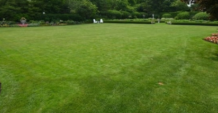I’m trying to incorporate more leafy greens into my garden. There has to be more than lettuce and spinach you can plant, right? Fortunately, there is! One of these is Kale. This relative of cabbage is one of the most cold-hardy vegetables and can withstand very low temperatures while maintaining its characteristic dark green to purplish color. It is also quite heat tolerant and can sometimes provide harvests through most of the summer in Kansas, although the leaves will have a stronger flavor.
There are several different types of kale, including curly types, flat-leaf types, and lacinato kale. All types of kale will perform well in Kansas during the spring and fall. Different types will be more appropriate for different cooking applications, so consider intended uses when selecting a variety.
When to plant. Kale is cold tolerant and can be direct-seeded in mid-March for a spring crop or in early August for a fall crop. Kale can be started indoors and transplanted outside for an earlier harvest.
Spacing. Plant seeds ¼ to ½ inch deep and thin seedlings to one plant every 8 to 12 inches in the row. Rows can be up to 15 inches apart. For small salad leaves, plants can be grown more closely together.
Crop rotation. If possible in your garden space, do not plant in areas where you have grown cabbage, cauliflower, broccoli, collards, Brussels sprouts, mustards, or turnips for the past 3 to 4 years.
Care. For best flavor, provide consistent moisture throughout the growing season. If leaves become bitter in the summer, replant in the fall for a continued crop. Mulch to help maintain even soil moisture. Row covers can help reduce insect pressure from cabbage worms and loopers.
Harvesting. For salad leaves, harvest individual leaves when they are 3 to 6 inches long. For larger, more mature leaves, cut older, lower leaves when they are full sized and tender. Cold weather improves the flavor. Kale can be left in the garden and used until a severe freeze damages the crop, usually in early December.




